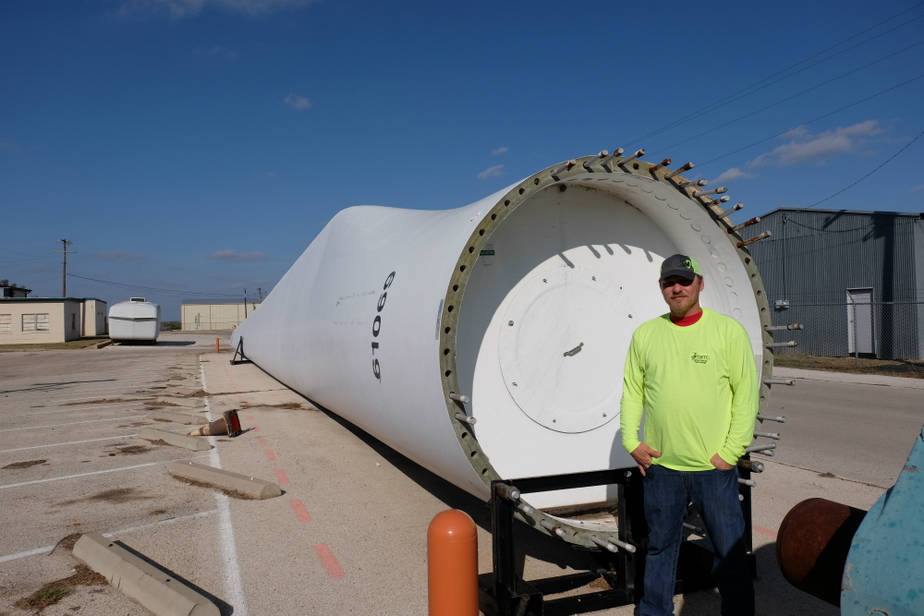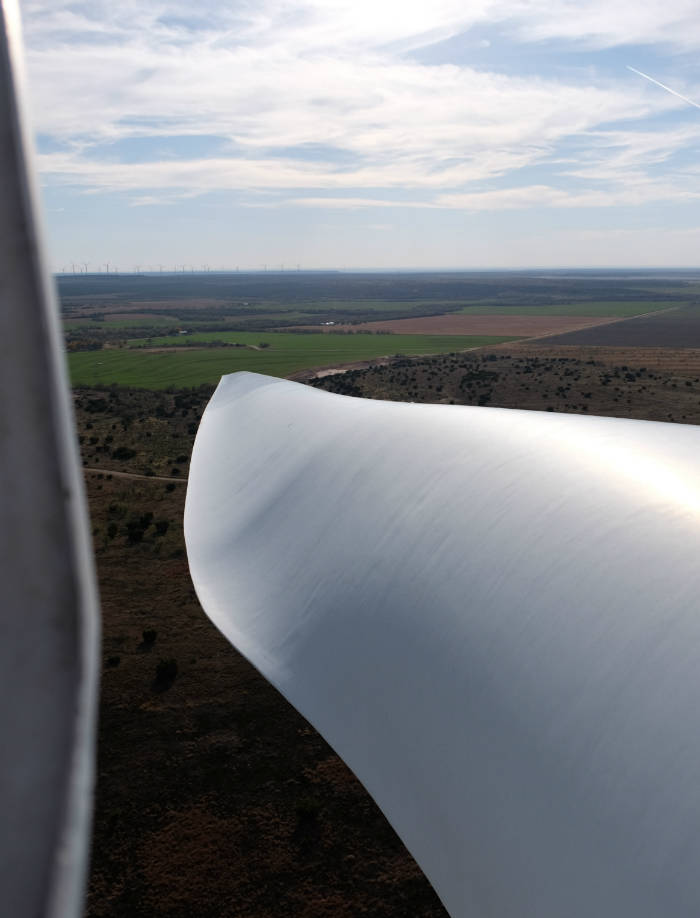The wind construction boom has slowed—or, perhaps more accurately, morphed—as the industry enters its second generation. Sweetwater has a population of about 10,000, and back at the peak of wind development in 2008, as the economy was crumbling, it was estimated that 18 percent of the town’s working population was employed on wind projects, Ken said. Now, he acknowledged, the number of full-time jobs in wind technology is a small fraction of that, but only if you disregard the hundreds of peripheral jobs that rely on the wind energy sector.
These complementary industries are the ecosystem that wind power belongs to—and its reach is growing. Repowering, which vastly increases efficiency by either replacing old turbines for more powerful ones or upgrading components, means more megawatts with the same footprint. It also means a whole new category of jobs. While I was there, evidence of these peripheral industries was everywhere. I watched 80-foot blades swapped out for ones twice as long. (The production tax credits helped these efforts, too.) I visited Global Fiberglass Solutions of Texas, which was setting up shop in an old aluminum recycling plant to process the decommissioned blades—which were being amassed in a 10-acre field—into building panels and other materials.
The wind industry is changing and the jobs base around it is expanding as existing turbines are retrofitted with new technology. Credit: Meera Subramanian
Across the street from Global Fiberglass Solutions was the Argentinian company EMA, which builds electrical breakers specially designed for renewable power systems and employs about a hundred people.
And down the road in Roscoe, in an old mercantile brick building inscribed with “Shelansky’s Dry Goods,” beside a high curb designed for horse carriages, teens at Edu-Drone were learning skills that would earn them FAA licensing as drone pilots. They were simultaneously earning a high school diploma and an associate’s degree, aiming for a career that could have them use the flying cameras to inspect wind turbine blades for damage from hail or lightning strikes.
The Wind Will Always Blow Here
Back at the TSTC turbine, high above the mesquite below, the elevator shuddered to a stop at the top. Well, almost at the top. While James, who had a hurt shoulder, waited below, I clipped in my lanyard line and climbed up the last 40-foot stretch to get up to the nacelle.
The four students who had climbed up by ladder were already there, along with Billie Jones Hudson, another TSTC wind instructor. Billie, 42, whose long brown hair was pulled back in a tight ponytail and tucked down her shirt, had been a prison guard and an elementary school art teacher before working in wind. Together we stood amid the hydraulics, cooling systems and electrical boxes of the nacelle. It was all basic mechanics, but supersized. Big bolts, smeared with grease, attaching one massive piece of metal to the next. There was the slightest of sway to the entire structure, which one student, Kaitlin Sullivan, 25, equated to a boat.
“You just feel like you’re on top of the world,” said Johnathon McCarthy, a West Virginia Marine who served in Afghanistan before starting the TSTC program. Credit: Meera Subramanian
With one more hoist, I could look out the hatch that opened up to the sky, the blades reaching to infinity, airplane wings on end. This is what everyone I spoke to in the wind industry loves the most about this work. It is the exact opposite of descending deep into the earth to mine coal in shafts no taller than the height of a small child. There is risk to wind work—an arc flash, a long fall—but never the prospect of being trapped underground for days as there is with coal. There are no oil leaks that can’t be staunched. It felt like freedom. Energy freedom. Professional freedom. Economic freedom. Our turbine’s blades were still, but I could see dozens of others spinning along the horizon below, the wind that blew through them altered, molecules shifted.
“It’s breathless,” was how student Johnathon McCarthy, a 28-year-old West Virginian who served in Afghanistan as a Marine, described being up there. “You see other turbines around you spinning. You see the cars that are just this small. You see the people down there and they’re even smaller, like ants. You just feel like you’re on top of the world.”
According to the Bureau of Labor Statistics, wind technician is currently the second-fastest growing job in America. Credit: Meera Subramanian
The best places for wind are often the places that are struggling to keep rural communities alive.
What was happening in Nolan County proved that the debate about how we generate our kilowatts doesn’t have to be about climate change. It could be about embracing whatever clean energy options are available to help make small-town America economically viable. In this deeply red place, it was the embodiment of President Barack Obama’s all-of-the-above strategy. At the close of 2016, 86 percent of the country’s onshore wind turbines were located in Republican districts, according to the 2016 U.S. Wind Industry Annual Market Report. Indeed, Republican Sens. Rob Portman of Ohio and John Thune of South Dakota were some of the primary advocates responsible for keeping the PTC in place in the final version of the tax overhaul bill, which was signed Dec. 22.
Too soon, it was time to leave our aerie. Kaitlin sung the words to “When It Rains” in a clear soprano voice, the confined space of the nacelle a perfect sound chamber, as we all worked our way down. I climbed back to where James awaited me, and we returned to our constrained positions in the elevator.
“What was advanced yesterday is no longer advanced today,” he said as we slowly descended, “and what’s advanced today will no longer be advanced tomorrow. Same way with wind turbines; they’re always advancing.” Periodically, light slipped through into our confined space, illuminating his face.
“This is a totally different world. I believe this is the future,” he said, pausing for a moment. Then he added, almost to himself, “I hope it’s the future.”
Top photo: Kaitlin Sullivan looks into the nacelle atop a wind turbine tower in West Texas. Credit: Meera Subramanian
Visits: 3




Be the first to comment